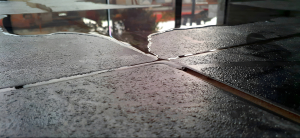Why slip-resistant flooring for holiday lets is vital

Last Updated on October 6, 2025 by admin
Having appropriate flooring material in your holiday let is one of the most important precautions that can be taken to prevent slips. Guests often come and go with wet shoes, sandy flip-flops, or muddy boots and areas such as toilets and kitchens can quickly become wet and slippery. This makes the choice of flooring in your property a crucial part of maintaining a safe and welcoming environment.
The amount of grip (or ‘slip resistance’) flooring offers to a person walking on it will depend on the surface finish of the floor and any contamination on it. All flooring will offer good slip resistance when clean and dry, but the presence of even small amounts of water, dust or grease can make smooth floors very slippery.
R-ratings for slip resistance
Slip resistant flooring is one of the most important safety features in a holiday let, protecting both guests and property owners from unnecessary risks. Floors with R-ratings for slip resistance are specifically designed to reduce the likelihood of slips and falls, which are among the most common causes of injuries in accommodation settings.
An R-rating is a safety classification that measures a floor’s slip resistance. The higher the rating, the greater the grip, making it a vital factor in flooring choices for public or rental propertie.
Best flooring for wet entrance areas
Installing anti-slip mats at entrances is another effective layer of protection. These mats trap moisture, dirt, and debris before they spread across interior surfaces, keeping walkways safer while also reducing cleaning demands. They are particularly important in high-traffic areas such as hallways, kitchens, and bathroom entrances where slips are most likely to occur.
How to improve floor slip resistance after cleaning
Equally important are safe floor cleaning methods. Using the wrong products can leave a greasy or slippery residue, undermining the floor’s slip resistance. Choosing cleaning solutions that are compatible with non-slip surfaces ensures that the flooring continues to perform as intended.
What is the slip resistance pendulum test?
Testing your floor with the pendulum test is the standard method for assessing slip resistance and is widely used in safety evaluations. It works by swinging a rubber slider across the surface to mimic the action of a heel striking the floor. The friction created is measured as a Pendulum Test Value (PTV). Results show the level of slip risk: 0–24 indicates high risk, 25–35 moderate risk, and 36+ low risk, which is generally considered safe. Because it can test both wet and dry conditions, the pendulum method provides a reliable, practical benchmark for ensuring floors meet health and safety standards. You can download detailed information on the pendulum test from the Health and Safety Executive website.
When to use warning signs while floors dry
When choosing new flooring, follow the Health and Safety Executive’s guidance on assessing the slip resistance of flooring. Usually, it costs no more to choose a suitable slip resistant floor over a smooth floor at the design stage. Over the lifespan of a building, making the right choice can save a lot of money by preventing slips.

Going to the source
If there are any leaks in your property, consider getting them repaired to avoid repeated water spillage on your floors.
Alternatives to installing new flooring
If it is not possible to replace flooring, you can get it treated to improve its slip resistance. Options include chemical etching, resin coatings, and anti-slip sealers, each enhancing traction in wet or high-traffic areas. In many cases, not all treatments will be compatible with your floor surface so getting specialist advice from a flooring expert is recommended.
Take precautions
Avoid creating changes in adjacent flooring surfaces that can give rise to a risk of slips. Unexpected changes in the amount of slip resistance particular flooring offers will significantly increase the risk of someone having a fall.
Slip resistant flooring is vital for preventing accidents in homes, workplaces, and especially public spaces like holiday lets. Slips and trips remain one of the most common causes of injury in the UK, leading to costly claims and serious harm. UK law, including the Health and Safety at Work Act etc. 1974 and the Management of Health and Safety at Work Regulations 1999, requires employers and property owners to ensure flooring is safe and suitable. Failure to address slip risks can result in liability, enforcement action, or compensation claims. Prioritising slip resistance protects guests, meets legal duties, and safeguards reputations.
To find out how to undertake a risk assessment for slips and trips, please read this blog here: Link to article: Risk Assessment for Slips and Trips
Get your quote on Holiday Let Insurance that accurately protects you and your property via our team of insurance experts. Whether you need a policy that includes cover for children’s play areas, hot tubs, or sports equipment and facilities, we can arrange it for you.
To find out how to undertake a risk assessment for slips and trips, please read this blog here:: Risk Assessment for Slips and Trips.
Get your quote on Holiday Let Insurance that accurately protects you and your property via our team of insurance experts. Whether you need a policy that includes cover for children’s play areas, hot tubs, or sports equipment and facilities, we can arrange it for you.
To discuss Home Insurance for your holiday home, cottage complex or second home, contact us today.
Call: 01237 429 444
Request a Quote: boshers.co.uk/get-your-quote/
This guidance is provided for information purposes and is general and educational in nature and does not constitute legal advice. You are free to choose whether or not to use it and it should not be considered a substitute for seeking professional help in specific circumstances.




